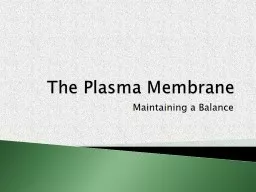

The plasma membrane is a SELECTIVELY PERMEABLE membrane that allows nutrients and wastes to enter and exit the cell Homeostasis maintaining balance in the cell The Plasma Membrane Selective Permeability allows some molecules to pass through and keeps others out ID: 919155
Download Presentation The PPT/PDF document "The Plasma Membrane Maintaining a Balan..." is the property of its rightful owner. Permission is granted to download and print the materials on this web site for personal, non-commercial use only, and to display it on your personal computer provided you do not modify the materials and that you retain all copyright notices contained in the materials. By downloading content from our website, you accept the terms of this agreement.
Slide1
The Plasma Membrane
Maintaining a Balance
Slide2The plasma membrane is a SELECTIVELY PERMEABLE membrane that allows nutrients and wastes to enter and exit the cell
Homeostasis: maintaining balance in the cell
The Plasma Membrane
Slide3Selective Permeability – allows some molecules to pass through and keeps others out
E.g. Screen on a window
Water can freely enter and exit the cell. Other particles such as Na
+ and Ca+ ions are only allowed in at certain times (selective permeability)
Selective Permeability
Slide4Slide5Phospholipid
The plasma membrane is composed of a PHOSPHOLIPID BILAYER (double layer)
A phospholipid molecule is a lipid which is composed of a glycerol, a phosphate, and two fatty acids
The two fatty acid tails of the phospholipid are NONPOLAR (not attracted to water) whereas the head of the phospholipid molecule is POLAR (attracted to water)
Slide6Slide7Polar Head
(glycerol + phosphate)
Nonpolar Tail
(fatty acids)
Slide8Phospholipid Bilayer
The two layers of phospholipid molecules make a sandwich with the fatty acid tails forming the interior of the membrane and the phospholipid heads facing the watery environments found inside and outside the cell
Slide9Slide10Slide11Slide12Slide13Slide14Cholesterol and Transport Proteins
Cholesterol is mixed into the plasma membrane and helps keep the fatty acid tails
from sticking together
Transport proteins span across
the plasma membrane and move
larger molecules through the
membrane
Slide15Slide16Slide17Cellular Transport
Slide18Water can pass freely through the plasma membrane by DIFFUSION
Diffusion – the movement of particles from an area of higher concentration to an area of lower concentration
Like gravity
High to Low
E.g. Perfume spreads from point of origin to evenly disperse around the room
Diffusion
Slide19Slide20Slide21Gas spreads out by diffusion!
Slide22Water
In the cell, WATER always moves to reach an equal concentration of both sides of the membrane
The diffusion of water across a semi-permeable membrane is called OSMOSIS
Slide23Osmosis
If two solutions with different solute concentrations are separated by a selectively permeable membrane (i.e. the plasma membrane), the water molecules will move from the solution with HIGHER WATER (lower solute) CONCENTRATION to the solution with LOWER WATER (higher solute) CONCENTRATION.
The solute
doesn’t
move; only the WATER moves
Slide24Slide2590% Water
70% Water
80% Water
80% Water
Slide26H
2
O
H
2
O
H
2
O
H
2
O
30% Sugar
(70% H
2
O)
15% Sugar
(85% H
2
O)
Cell
Environment
Water moves from high concentration of water
to lower concentration of water
Slide27Facilitated Diffusion
Facilitated Diffusion – transport of materials across a membrane with the aid of transport proteins (no energy)
Proteins act like a gate or channel that opens and closes to let materials in and out
Slide28Slide29Osmotic Solutions
Isotonic Solution
– the concentration of water is EQUAL on both sides of the membrane. Water moves in and out of the cell equally
Hypotonic Solution
– the solute concentration is higher inside the cell than outside the cell. Water will move into the cell by osmosis and the cell will SWELL in size
Hypertonic Solution
– the solute concentration is lower inside the cell than outside the cell. Water will move out of the cell by osmosis and cell will SHRINK in size
Slide30Slide31Slide32Concentration Gradient
CONCENTRATION GRADIENT - When there is an unequal concentration of solutes on different sides of a membrane
WITH concentration gradient
AGAINST concentration gradient
Slide33PASSIVE TRANSPORT - Particles naturally move WITH the concentration gradientHigh
Low
NO ENERGY is needed
Diffusion = passive
Osmosis = passive
Facilitated Diffusion = passive
Passive Transport
Slide34Active Transport – moves materials AGAINST the concentration gradientLow
High
REQUIRES ENERGY!
Active transport uses TRANSPORT PROTEINS + ENERGY to move materials from low concentration to high concentration
Active Transport
Slide35ENERGY
!
Slide36Slide37Endocytosis/Exocytosis
Endocytosis
– the whole cell engulfs something
Exocytosis
– the whole cell ejects something
Slide38Slide39